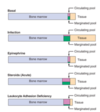Lecture 1.3: WBC Disorders Flashcards
(38 cards)
Which 7 drugs, hormones, or toxins which are common causes of acute neutrophilia?
- Corticosteroids
- Epinephrine
- Lithium
- Endotoxin
- Smoking
- Vaccines
- Venoms

What are some common causes of demargination syndrome leading to neutrophilia?
- Vigorous exercise
- Acute physical and emotional stress
- Infusion of epinephrine and other catecholamines

Shift of neutrophils from the marginal to circulating pool is quantitatively more important from which vascular bed and can account for about a doubling in neutrophil count?
Pulmonary capillaries
An increase in which cells in the blood can be helpful in distinguishing neutrophilia due to demargination from other causes such as infections, protracted stress, or glucocorticoid administration?
↑ in lymphocytes + monocytes + neutrophils
Acute neutrophilia occurs as a consequence of release of neutrophils from where; this type of neutrophilia is seen in response to what?
Marrow storage pool; in response to inflammation and infections

Inflammation or tissue necrosis, due to burns, trauma, gout, or vasculitis are causes of what type of neutrophilia?
Acute neutrophilia

Malignancy is a cause of what type of neutrophilia?
Chronic Neutrophilia

Asplenia and myeloproliferative disorders are causes of what type of neutrophilia
Chronic neutrophilia

If neutrophilia persists after repeat labs, what is the next step (flow chart)?
- Examine smear: Leukoerythroblastic?
- Yes: then proceed to BM examination: morphology, cytogenetics, culture
- No: determine if pt is febrile (if yes, evaluate and treat), if not then do serologies for AID

If blood smear of pt with neutrophilia shows leukoerythroblastic cells, what are you looking for with the BM examination and what are the DDx’s?
- Tumor granulomatous dx
- Ph1 or BCR-ABL —> CML
- JAK2 mutation –> Non-CML MPN = PCV or myelofibrosis

Smoking and obesity can be associated with what WBC abnormality?
Mild neutrophilia

Lymphocytes displaying coarse, clumped chromatin, in pt with lymphocytosis should raise suspicion of which primary marrow disorder?
CLL
Readily identifiable lymphoblasts in pt with lymphocytosis should raise suspicion of which primary marrow disorder?
ALL
An excess of large granular lymphocytes, particularly in a pt with RA, should raise suspicion of which disorder?
Large granular lymphocytic (LGL) leukemia
Why is examination of the blood lymphocytes in pt with lymphocytosis so important?
Lymphocyte morphology is generally more informative than is the case in neutrophilia
Larged lymphocytes with cleaved nuclei may be seen in which cause of lymphocytosis?
Follicular lymphoma
Pt presenting with rhinosinusitis, asthma, and eosinophilia should trigger screening for what?
Eosinophilic granulomatosis with polyangiitis (Churg-Strauss syndrome)
List 3 medications which are common causes of eosinophilia?
- Antibiotics
- NSAIDs
- Antipsychotics
List 5 allergic diseases associated with eosinophilia
- Allergic rhinitis
- Atopic dermatitis
- Urticaria/angioedema
- Fungal allergy
- Asthma

Unexplained monocytosis, particularly in elderly patients with other cytopenias, should reflex concern for what; which work-up is generally warranted?
- Myeloid malignanacies, such as MDS and CMML
- Generally warrants examination of bone marrow
List 6 antibiotics associated with idiosyncratic neutropenia?
- Cephalosporins
- Clindamycin
- Gentamicin
- Sulfonamides
- Tetracyclines
- Vancomycin

List 3 anticonvulsants associated with idiosyncratic neutropenia
- Carbamazepine
- Mephenytoin
- Phenytoin

Which antidepressant is associated with idiosyncratic neutropenia?
Amitriptylene

List two H2 blockers associated with idiosyncratic neutropenia.
- Cimetidine
- Ranitidine







